POST-PANDEMIC ANALYSIS OF MIDTOWN MANHATTAN NEW DEVELOPMENT SALES
While many submarkets across New York City are experiencing an uptick in new development sales activity in 2021, a section of Midtown has seen a decline. How has this submarket, home to Billionaire’s Row and the most expensive condo buildings in the city, performed compared to other submarkets with a similar concentration of new development?
Marketproof New Development conducted a longitudinal study of the new development market in Midtown, focusing on the area between 50th Street and Central Park South from river to river. We compared activity in this section from 2021 with the same period in 2019 and we analyzed that performance against other new development condo-centric submarkets, including Hudson Yards, Chelsea and FiDi.
SUMMARY
Midtown underperformed in post-pandemic 2021 (1/1/2021 – 10/31/2021) when compared with the same time period in pre-pandemic 2019 (1/1/2019 – 10/31/2019) in several key metrics.
- -5.94% in number of contracts signed
- -13% in aggregate dollar volume of contracts
- -10.86% in average price / sq ft
- -7.5% in average unit price
48% of unsold new condo units are priced above $10M in this section of Midtown while the Manhattan average contract price was $4.04M for the first 10 months of 2021. This price discrepancy may partially explain the relative poor performance of the Midtown submarket.
NUMBER OF CONTRACTS SIGNED
Compared to the same period in 2019, Midtown had a 5.9% decrease in the number of contracts reported in 2021.
The number of contracts reported for the first 10 months of 2021 was 95 compared to 101 in the first 10 months of 2019.
This section of Midtown was the only submarket to see a decrease in contract activity in Manhattan. The percent change falls short of other markets that have a similar concentration of new development projects.
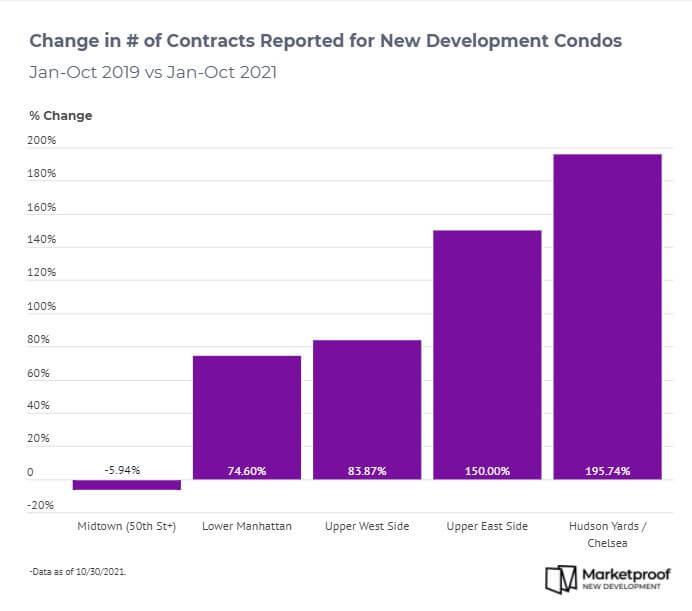
AGGREGATE $ VOLUME OF CONTRACTS
Compared to the same period in 2019, Midtown had a 13% decrease in the aggregate dollar volume of contracts reported in 2021.
The total dollar volume of contracts reported for the first 10 months of 2021 was $678M compared to $779M in the first 10 months of 2019.
This section of Midtown was the only submarket to see a decrease in aggregate dollar volume in Manhattan. The percent change falls short of other markets that have a similar concentration of new development projects.
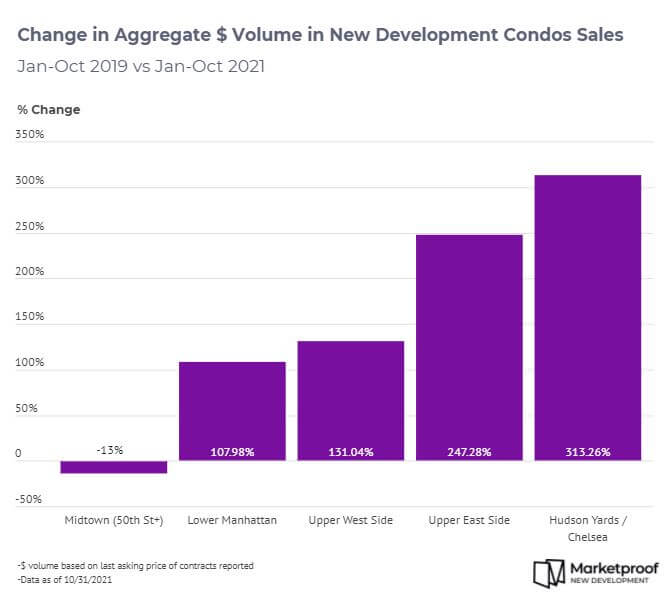
AVERAGE PRICE / SQ FT
Compared to the same period in 2019, Midtown had a 10.9% decrease in the average price / sq ft in 2021.
The average price / sqft for the first 10 months of 2021 was $2,715 compared to $3,046 in the first 10 months of 2019.
This section of Midtown was the only submarket to see a decrease in average unit price in Manhattan. The percent change falls short of other markets that have a similar concentration of new development projects.
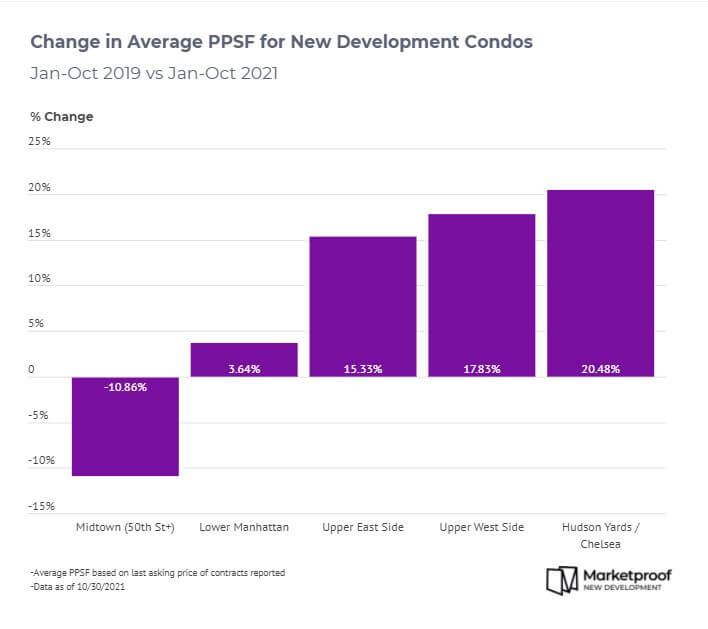
AVERAGE UNIT PRICE
Compared to the same period in 2019, Midtown had a 7.5% decrease in the average unit price in 2021.
The average unit price for the first 10 months of 2021 was $7.1M compared to $7.7 in the first 10 months of 2019.
This section of Midtown was the only submarket to see a decrease in average price / sq ft in Manhattan. The percent change falls short of other markets that have a similar concentration of new development projects.
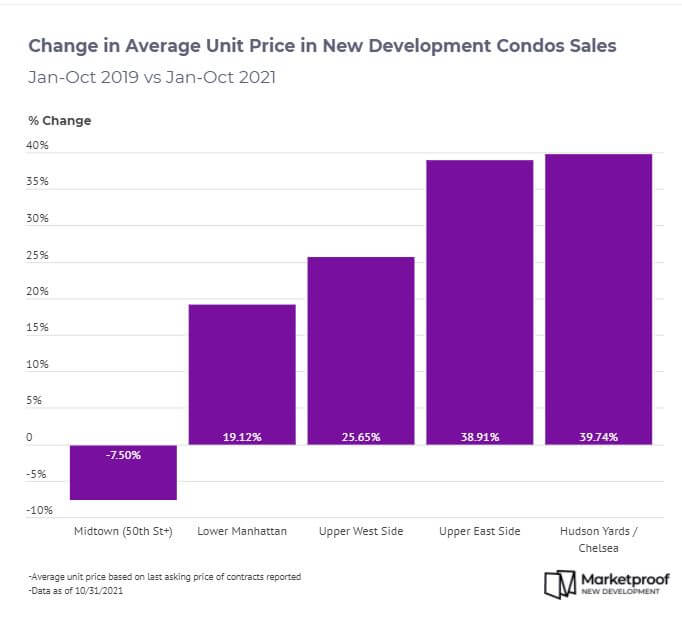
PRICE DISTRIBUTION
In this section of Midtown, 48% (194 units) of unsold new development inventory is price above $10M.
The average unit price that went into contract in the first 10 months of 2021 was $4.04M across Manhattan as a whole.
The concentration of higher priced units may partially explain the relative poor performance of this section of Midtown.
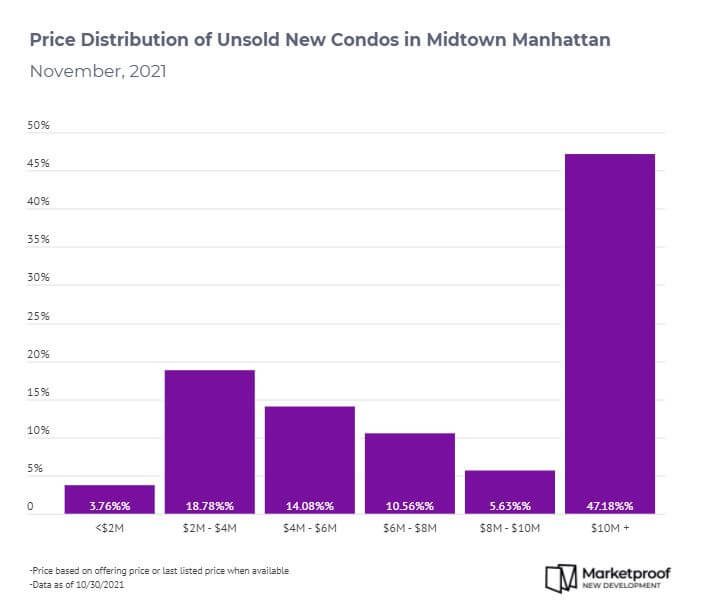
Report Methodology
Pre-pandemic is defined as the period from 1/1/2019 to 10/31/2019, well before the first reported case of COVID. Post-pandemic is defined as the period from 1/1/2021 to 10/31/2021, well after the rebound in real estate activity post initial COVID lockdown. Same 10-months period is used to remove seasonal variance.
- Prices are based on the last asking price before a unit was put into contract
- Projects are sponsor stage (sponsor controlled) that are eligible to sell units
- Price distribution is based on the availability of offering plan price or listed price of unsold units
- Prices are based on the last asking price before a unit was put into contract



































